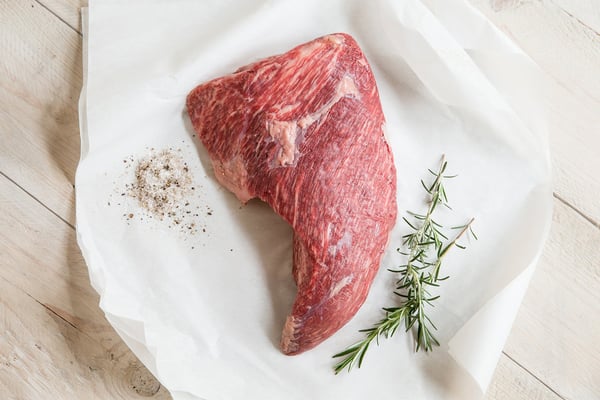.jpg?width=600&name=TriTipCooked-Web-rotated%20(1).jpg)
Ribeye, filet, sirloin, T-bone … oh my! You know these usual suspects, but how well do you know tri tip? This cut—once known simply as “the triangle part”—is a rare gem, and one that you need to add to your grilling and roasting rotation stat.
What the heck is tri tip?
Tri tip is the triangle-shaped muscle located in the bottom portion of the sirloin section of a steer. Whole and untrimmed tri tip roast will weigh about 5 pounds, but by the time it hits the shelves, a tri tip will be about 2 to 3 inches thick and weigh 1½ to 2½ pounds.

In the beginning ...
This triangle cut was never the most beloved of meats. Because there is only one tri tip per side of beef—or two cuts per animal—the cut was most frequently ground up or cubed for soup because it wasn’t as sexy to display as other, more plentiful cuts.
So how did tri tip make it onto the plate? Depending on whom you ask, you’ll hear about any number of locations where it got its start, including:
- Florence Prime Meat Market in Manhattan circa the 1940s
- Jack’s Corsican Room in Long Beach, California, circa 1955
- Desert Provisions in Palm Springs, California, circa 1964
- Otto Schaefer Sr. in Oakland, California, circa the 1950s
- Safeway in Santa Maria, California, circa the late 1950s
Origin stories aside, one thing is for sure: The cut became a serious local favorite in Santa Maria and is the primary cut used today in Santa Maria-style barbecue. As a result of its many, many origin points, it’s sold under many monikers:
- Santa Maria steak
- Tri tip sirloin steak
- Bottom sirloin roast
- Triangle roast
- Newport steak (when cut into individual steaks)
- Aiguillette baronne (France)
- Punta de anca, punta de Solomo, and colita de cuadril (Latin America)
- Maminha (Brazil)
How do I cook tri tip?
Tri tip is a pretty versatile cut of meat—but Wagyu tri tip is a true steak standout. Why? Whereas run-of-the-mill tri tip is considered incredibly lean, Wagyu tri tip is beautifully marbled. In fact, Lone Mountain Wagyu’s tri tip contains, on average, 32 percent intramuscular fat for a rich, buttery flavor. You can read more information on marbling in general—and on marbling levels of Lone Mountain Wagyu—by clicking here.
There are plenty of ways to enjoy tri tip, but the most popular is Santa Maria-style—whole and seasoned with S&P and grilled until medium-rare over red oak wood. Tri tip is also delicious roasted whole on a rotisserie, pit smoked, oven roasted, or sliced across the grain into steaks and then seared on the grill and finished with braising in a Dutch oven. If you’ve always wanted to enter a chili competition, tri tip is a winning choice for competition chili.
Also? Because of its shape, tri tip cooked up as a roast is a perfect cut for serving people who like different levels of doneness. The thicker portions will stay more rare while the thinner section will head toward medium, so you’ve got something for everyone.
Here are a few recipes to get you moving:
- Grilled Wagyu Tri Tip with Charred Scallion Sauce
- Tri-Tip Steak a la Parrilla with Chimichurri and Roasted Onions
- Sous Vide Tri-Tip with Cilantro Butter
- Japanese-Inspired Tri Tip Recipe
- Cast Iron Mediterranean Tri-Tip Steak
What do I serve with my tri tip?
Red meat loves to pair up with starches and green things, so think potatoes and veggies. If you’re roasting the tri tip, give these side dishes a try:
- Roasted asparagus
- Fresh spring greens salad
- Roasted brussels sprouts or haricots verts
- Baked potato or garlicky mashed potatoes
If you’re grilling your tri tip, keep it fresh with mango salsa or throw some peppers and zucchini on the grill with the meat. Another option instead of going green and starchy is to eat like a local and pair your Santa Maria steak with some Santa Maria-Style Pinquito Beans.
Have we properly whetted your appetite? Live dangerously and embrace the otherworldly experience that tri tip brings to the plate—order now.





